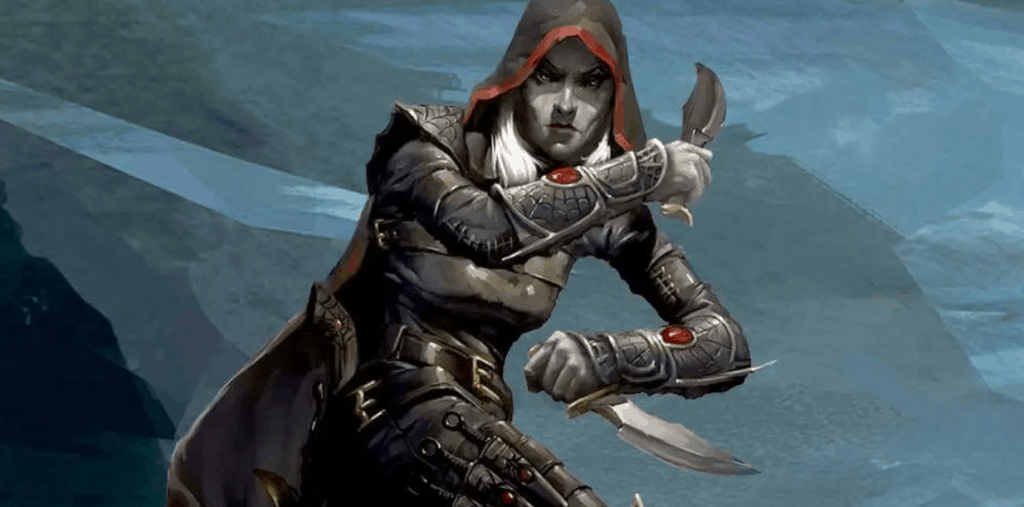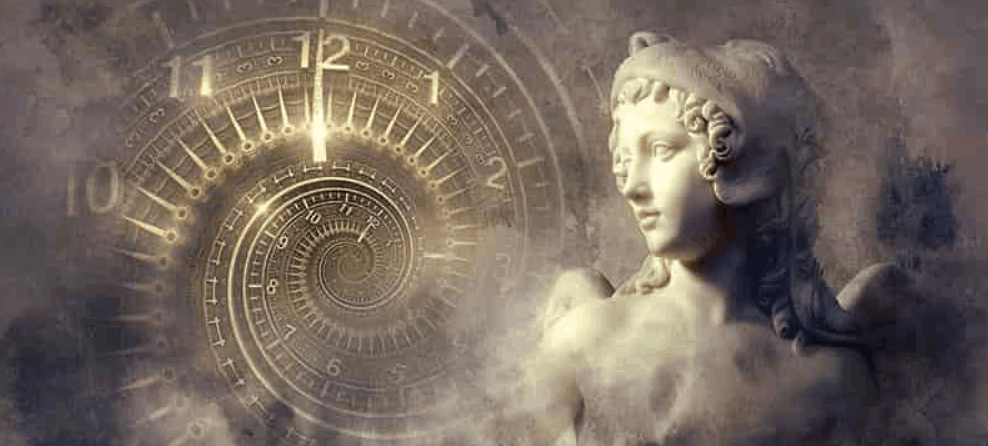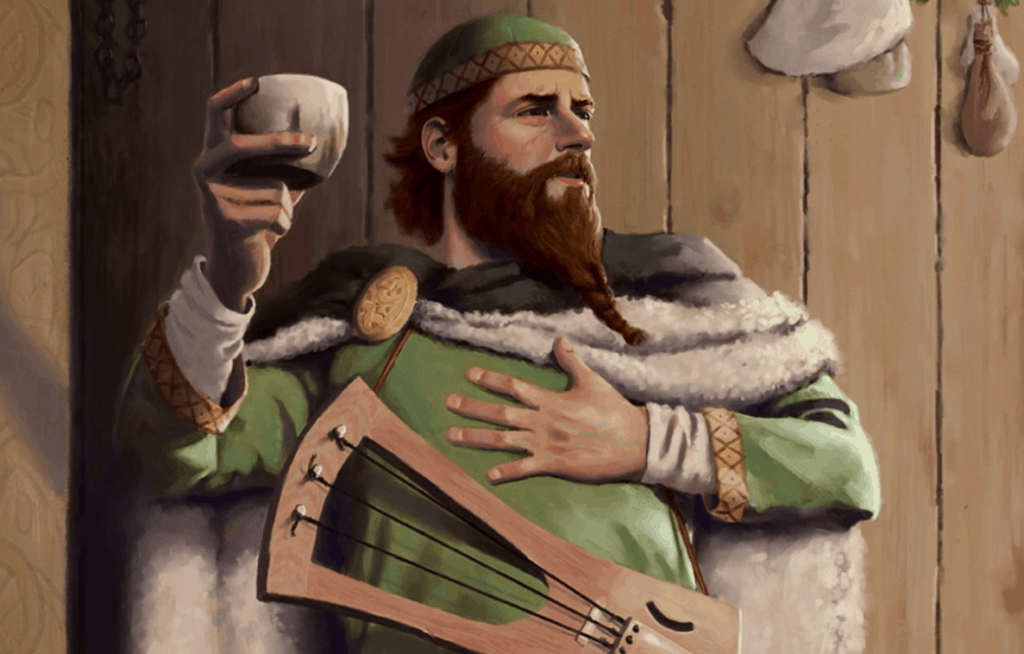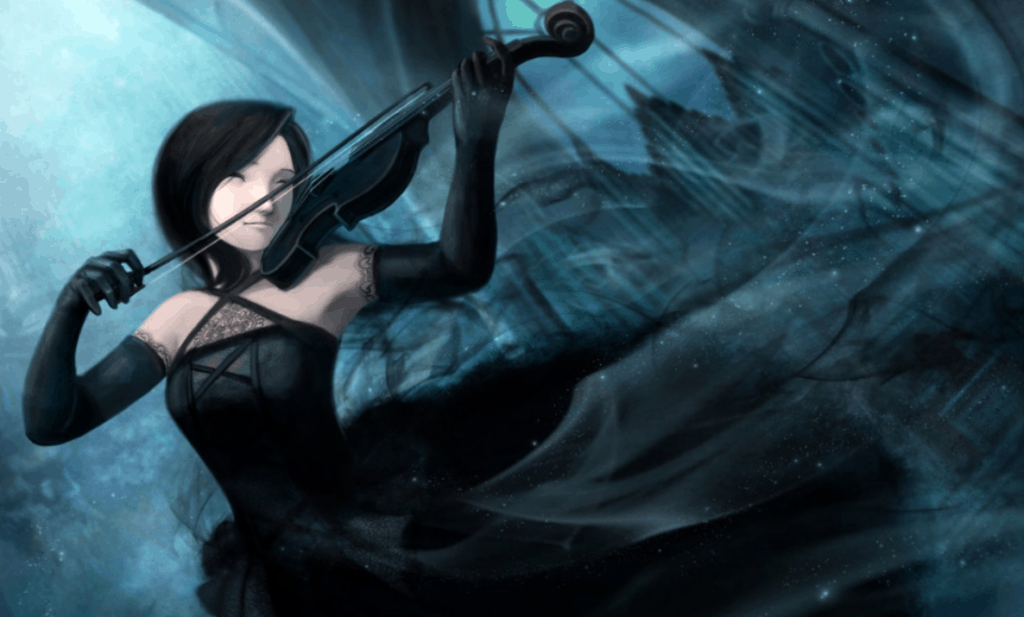It’s D&D night, and Seymour the rogue is hiding behind an ominous obelisk, ready to throw a dagger at the Arcanaloth who flies over the battlefield. He hurls the blade, attacking with advantage, but rolls a 2 and a 9 on the dice. After adding his modifiers, it’s a 16 to hit. Seymour needs this attack to land to deal sneak attack damage and save his unconscious allies that the monster is heading towards.
Suddenly, a voice across the table pipes up. “You have inspiration!” Seymour hears this and picks up another die, rolls it, and boosts his attack roll to 21. “That hits,” says the DM. The table cheers and Seymour starts rolling his damage.
What just happened? How could this rogue boost their attack roll? Who was this mysterious yet sultry voice that came from across the table? The answer lies in the ultimate support class and its most iconic feature: bardic inspiration. Keep on reading our Bardic Inspiration 5e Guide to find out everything you need to know about this ability.
What is Bardic Inspiration?
Bardic Inspiration is an ability that all bards get at 1st level. This ability allows you to use your bonus action to inspire an ally within 60 feet of you and give them a small bonus to one d20 roll within the next ten minutes in-game. The ally who receives it can decide when and what they use it on. Once your ally uses it, the die is lost, meaning it can’t be used again.
The bonus they receive is a d6. However, this die gets larger as you level up as a bard. At 5th level, it becomes a d8, at 10th level, it becomes a d10, and at 15th level, it becomes a d12. This is specifically your amount of levels as a bard. If you are multiclass, you could be a 10th level character but only have 5 levels of bard. Therefore, your bardic inspiration die would still be a d8.
You start each day with a number of bardic inspiration uses equal to your charisma modifier. For example, if you have a Charisma score of 17, your modifier is +3. This means that you can inspire someone three times. Your expended uses refresh after a long rest.
One of the key features of this inspiration is that your ally can choose to roll the bonus after they roll their d20 but before the roll is determined to be a success or a failure. For some rolls, you might already know what the goal is, or the DM might tell you. For example, after a few rounds of combat, you might be able to deduce an enemy’s AC based on what has hit and what has missed. D&D Spells like Counterspell have set DCs when cast and you can know whether or not you’ve already passed.
While your allies ultimately determine what to use their inspiration on, it is useful as a bard to know what they can use it for. After all, they won’t have your class features memorized. Here are the main ways to use bardic inspiration.
Attack Roll

The rogue in your party makes an attack roll and the result is a 14. Before the DM tells the table whether or not it hits the enemy, the rogue can decide to roll a d6 and add the result to that 14, potentially reaching as high as 20.
Using bardic inspiration for attack rolls is the most common use of this feature at lower levels when you’re mostly focused on landing more attacks than your opponents. Use this primarily on allies with single high-damage attacks like a rogue or a ranger. Classes like the monk rely on making many attacks, with their damage output spread throughout. Since bardic inspiration can only affect one roll, you won’t be able to help as much. Classes like the cleric can act as a striker with high damage attacks like Inflict Wounds or Guiding Bolt.
It’s therefore important to understand the strengths of your party members so that you can give out your inspiration effectively. Bardic inspiration is also a great way of making every member at the table feel a part of the game. No one enjoys coming to a game of D&D and missing every attack for the week. If someone is rolling particularly bad, inspire them so that they can land their attack and do something cool. As a bard, you have a great opportunity to support both the characters in the game and the players around the table.
Ability Check
Any ally who has been inspired can add your bardic inspiration bonus to an ability check within the time limit. Ability checks include any skill check, checks to open doors, and find traps. There is a large variety of checks that players can make in D&D.
The issue with using a bardic inspiration on an ability check is that it’s hard to know what the consequences of failing an ability check are going to be. Does failing an athletics check to jump across a crevasse mean that your character will fall to their death or does it mean you will get a handhold on the edge and you’ll have another chance to pull yourself up?
Another challenge of using inspiration on ability checks is that it takes place out of combat and you might run out of time. Bards will want their inspiration to be used and if you are traveling through the wilderness for hours, it’s difficult to know what ten-minute time frame will be useful to have inspiration for whereas most combat encounters last less than one minute.
You could inspire the cleric to supplement their clanky armor when making stealth checks. You could inspire the wizard who’s planning to use Counterspell and will need to make an ability check to make it work. You could inspire the druid or rogue when you sense you’re about to enter combat so that they can use their inspiration on their initiative roll and go first in combat. Initiative rolls are dexterity checks and therefore bardic inspiration can be added to it.
Saving Throws

Saving throws are typically made less often than attack rolls and ability checks. However, when you are asked to make a saving throw, you want to succeed. Failing a saving throw can often mean being subjected to the most powerful spell effects, conditions like being restrained or paralyzed, or taking double the amount of damage.
Encounters that involve spellcasters, monsters that can paralyze, grapple, or otherwise subject the party to nasty effects can be largely negated by use of bardic inspiration. If you manage to inspire someone before they drop unconscious, they can even add your bardic inspiration die to their death saving throw, potentially saving their life!
When you inspire an ally, you might have a specific idea in mind of what they should use it for. You can even tell them what they should save it for. However, it’s ultimately up to them when they use it. You might inspire a barbarian so that they can add the bonus to their attack roll and they instead use it on a grapple check.
Magical Inspiration (TCoE)
This is an optional feature introduced in Tasha’s Cauldron of Everything. This allows an ally to use a bardic inspiration that you’ve given them to add the roll to the damage or healing of a spell that they’ve cast. It’s limited to only one target of the spell, so you cannot add it to everyone in Mass Healing Word or similar. Therefore, it equates to an additional 3 hit points of healing or damage. Considering the other uses of bardic inspiration, this is probably a waste of the die.
Font of Inspiration
Once you reach the 5th level as a bard, you regain all your expended uses of bardic inspiration after a short rest rather than after a long rest. The game assumes that you are taking two short rests each day. Therefore, this ability effectively triples the number of uses you have each day.
Superior Inspiration

The bard’s capstone feature. At the 20th level, you regain one use of bardic inspiration when you roll initiative and have no uses of bardic inspiration left. It’s underwhelming as a capstone feature but it means that you’ll always have at least one bardic inspiration to give.
Additional Uses of Bardic Inspiration
In addition to the basic uses of bardic inspiration, each bard subclass has its own special use of this resource. Some of these abilities make sense thematically as you magically inspire others to hit a little bit harder. However, others seem to simply use bardic inspiration as a resource to manage alongside other uses or to make it feel like a bard ability when it’s not really.
College of Lore Bards (PHB)
Lore bards get the ability Cutting Words. This ability allows you to use your reaction to subtract what you roll on your bardic inspiration from an enemy’s attack roll, ability check, or damage roll. Most often, this will be used to make an enemy miss their attack.
Cutting Words doesn’t suffer from the guessing game of adding to attack rolls since you know ACs of your entire party and the DM will typically announce what they rolled to hit. This feature notably doesn’t allow you to subtract from an enemy’s saving throw. Even without that feature, this is a powerful ability. However, it doesn’t work if the enemy can’t hear you or is immune to being charmed, which includes a large portion of the monsters in the game.
Lore bards also get Peerless Skill at 14th level, allowing you to add your bardic inspiration to an ability check that you make. Since you can’t normally use bardic inspiration on yourself, this is a great ability to add to a counterspell or initiative roll.
College of Valor Bards (PHB)

Valor bards are martially focused and gain the ability Combat Inspiration. This ability has two uses. The first lets your allies add their bardic inspiration to a damage roll they make with a weapon. The second is that your ally can use their reaction to add their bardic inspiration to their AC when attacked.
The first use gives you a small boost to your ally’s damage output. Since the boost is extra damage, the roll is doubled on a critical hit, making it a fun option for more damage. The second use of this ability is a slightly worse version of the lore bard’s Cutting Words. You must have already given that character inspiration and they must use their reaction to boost their AC. The upside is that there is no limitation on which creatures it works against. When used correctly, it can keep your front liners alive.
College of Glamour Bards (XGtE)
Glamour bards gain the ability Mantle of Inspiration. This ability uses your bonus action and enables you to grant your allies temporary hit points and move half their speed without provoking opportunity attacks. The number of people you can affect is equal to your charisma modifier.
Each ally gains 5 temporary hit points and this increases according to your level. When you reach 5th level, they each gain 8 temporary HP, 11 at the 10th level, and 14 at the 15th level. This ability can completely change the course of a battle. You can add at least 15 hit points to your team and a maximum of 70 hit points at higher levels.
Letting your allies reposition on the battlefield can get them out of danger or tee up a powerful attack combination in the coming turns. Moreover, This ability only uses one bardic inspiration.
College of Swords Bards (XGtE)
Sword bards are martially focused and gain Blade Flourishes at 3rd level. This ability lets you expend a use of your bardic inspiration to deal additional damage and either a) boost your AC by the roll, b) also damage other enemies next to you or c) push your enemy back and follow them up if you want.
Compared to other subclasses’ uses of bardic inspiration, this can be underwhelming. Boosting your AC or hurting multiple enemies can be good when you’re vastly outnumbered. However, you could take the Dodge action instead.
College of Whisper Bards (XGtE)

Whisper bards get the ability Psychic Blades. This ability lets you use a bardic inspiration to deal an additional 2d6 damage to a weapon attack. While College of Swords bards are limited to using a blade, this ability at least works with ranged attacks as well.
The damage scales with your level and feels similar to a rogue’s sneak attack. Psychic damage is rarely resisted, which makes it a more reliable damage source. Unfortunately, you can easily be more effective with spells.
College of Creation Bards (TCoE)
Creation bards get Mote of Potential, which gives additional effects to the basic uses of bardic inspiration depending on what kind of d20 roll your inspiration is used on.
When added to an attack roll, the target of the attack must succeed on a Constitution saving throw or take thunder damage equal to the die roll. When added to an ability check, your ally can roll the die twice and pick the one, effectively giving ‘advantage’ on the bardic inspiration roll. When added to a saving throw, your ally also gains temporary hit points equal to the die roll plus your charisma modifier.
These are all great bardic effects that don’t cost anything extra to use.
College of Eloquence Bards (TCoE)
College of Eloquence bards are built around the reliability and power of their bardic inspiration. Firstly, you gain Unsettling Words, which allows you to roll a bardic inspiration as a bonus action to subtract from the next saving throw they make in the round. Follow it up with a powerful save-or-suck spell for maximum effect.
You also get Unfailing Inspiration, which allows your allies to keep the inspiration die you give them if they use it and it fails. The biggest problem your allies have with bardic inspiration (besides remembering to use it) is rolling so low that they need to roll the highest number on the die to succeed. Now they can roll and if they don’t make it, they can keep the die and try again.
Lastly, when an ally uses their bardic inspiration and succeeds, you can use your reaction to give a different ally another inspiration without expending one of your uses. You can do this a number of times equal to your charisma modifier, which, at 14th level, is 5 times. This effectively gives you 5 extra uses of bardic inspiration each day.
College of Spirits Bards (VRGtR)

Spirits bards gain the ability Tales From Beyond. You reach out to dead spirits, who tell tales through you. As a bonus action, you can use your bardic inspiration to learn a particular tale from beyond, according to the Spirit Tales table in VRGtR.
Before you rest, you can tell that tale to another creature, who receives its effects. The effects include bardic inspiration on every mental ability check for ten minutes and dealing force damage to the target. As your bardic die increases in size, you can roll more powerful effects like incapacitating or stunning creatures.
While this ability is random in that you roll to see which effect you get, you can at least know ahead of time which tale you have loaded up before unleashing it, allowing you to plan accordingly. At 14th level, you can roll on the table twice and pick your favorite option.
Practical Advice for Using Bardic Inspiration
Between the basic abilities to the subclasses features, there are many ways to use bardic inspiration. Along with spellcasting, this feature is a central feature to playing a bard well, so you want to be as effective with it as possible. Here are some tips for using your bardic inspiration:
- Remind the Party. It can be a meme, but your party members will probably forget about the inspiration you give them. It’s not because they aren’t thankful nor is it a criticism of you. They just have a lot of things that they’re already trying to keep track of. You’ll most likely need to remind your party members that they have an inspiration die.
- Use Actual Dice. If you’re playing in person, have the correct amount of dice in front of you that represent your bardic inspiration dice. When you inspire someone, hand it to them both as a reminder that they have it and as a way of tracking your own resources. If you’re playing online, you can have dice in front of you as a visual reminder of how many you have left.
- Know Your Actions. Keep in mind what actions you use. Using your bonus action to give a bardic inspiration means that you won’t be able to cast Healing Word. Lore bards will be deciding when to use Cutting Words and when to save their reaction for Counterspell. This can also be useful when you’re considering which feat to pick or how to multiclass. For example, the Telekinetic feat uses your bonus action a lot. While it’s thematically interesting, it’s competing with your current abilities.
FAQ
Question: What can I add bardic inspiration to?
Answer: You can add a bardic inspiration die to one ability check, attack roll, or saving throw within ten minutes of receiving it. Valor bards can let you add it to damage or your AC, while Creation bards have additional effects based on how you use it.
Question: Can you get more bardic inspiration?
Answer: The two main ways to increase your bardic inspiration are to increase your charisma score and to level up. You have a number of uses equal to your charisma modifier. Increasing this gives you more uses. As you level up, each die increases in size, and at 5th level, your uses refresh after a short rest.
Question: Is bardic inspiration a spell?
Answer: No. This means that effects that negate or counterspells don’t work against bardic inspiration. It can even work within antimagic fields.
Question: Can you give inspiration to yourself?
Answer: No. When you use this feature, you have to use it on someone other than you. One exception is the lore bard’s Peerless Skill ability.
Question: Can two bards give one person inspiration?
Answer: No, since the PHB states that a creature can only have one bardic inspiration die at a time.
Summary
Bardic inspiration is one of the central, iconic features of the bard class.
- As a bonus action, you inspire an ally within 60 feet who can hear you, giving them an additional die to add to one attack roll, ability check, or saving throw in the next ten minutes.
- They can use the die after they roll the d20, but before the DM determines the outcome of the roll.
- Once the inspiration die has been rolled, it is used and cannot be used again until after a long rest. After 5th level, inspiration refreshes after a short rest.
- The die increases as you level up.
- Each bard subclass has unique abilities that expend uses of bardic inspiration.
Bards are a great support class that enables the people around them to be even more heroic than when they’re on their own. Using bardic inspiration effectively makes a powerful party dangerously effective at what they are doing.
- Armor of Agathys 5e Guide: What is Armor of Agathys? - August 3, 2022
- Oath of the Ancients 5e Guide - August 3, 2022
- Dissonant Whispers 5e Guide - July 20, 2022

